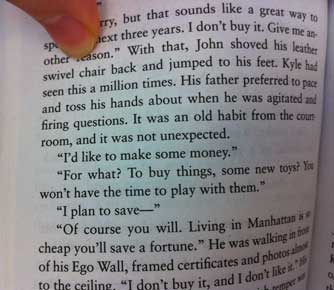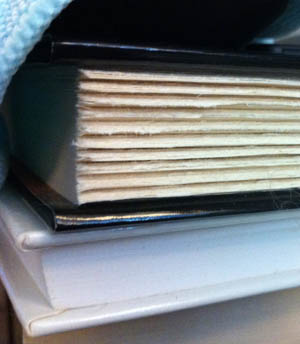: Paperback versus Kindle
I have had a fascinating experience.
The last three novels I read on my Kindle. But this week I lent my Kindle to my mom so she can see how she’d like it, and if she would use it. I was going to start a new novel on my iPad, for comparison, but then I noticed a John Grisham paperback I’d bought recently at Costco. I’d forgotten about it, but since I just finished a Grisham book, I was in the mood for another, and I picked up the paperback and started reading.
To my surprise, I have found the paperback experience to be considerably worse than the Kindle!
Here are the negatives I discovered:
- Paperback paper is thin, so there is show-through of the text on the back of the page. It makes all the text have a grayish dropshadow behind it.
- Paperbacks tends to curve, especially toward the spine, so the reading surface is not flat. I have never noticed this as a reading detriment before (since there wasn’t an alternative), but after reading the always-flat Kindle page, I dislike the curved surface intensely.
- Paperback is bulkier than Kindle (though a similar weight)
- Paperback requires I fuss with a bookmark to remember my place. (When I fell asleep while reading, the paperback closed and lost my spot. That does not happen with Kindle, as after ten minutes of inactivity it merely joins me in my slumber.)
- Paperback requires more physical effort to turn pages.
- Often I accidentally turn multiple pages as the thin paper allows two or more pages to stick together.
- The paperback’s margins are narrow, so on the outside my thumbs cover up the text, requiring me to shift my hands around constantly.
- A paperback’s paper quality is poor (not a bright white) resulting in a similar lower-contrast off-white reading experience as the Kindle. I had assumed paper would have a better contrast ratio, but that is not necessarily the case.
 [Click to enlarge]
[Click to enlarge]Possibly some of these issues are unique to this particular book or to paperbacks in general (i.e. hardbacks usually have better paper and wider margins, though of course they are bigger and heavier). Still, the results are intriguing: if after such a short time I prefer the Kindle this much more, I would guess that within a few months or a year, I shall not want to read any book in print form.
With print publishers cutting costs and using cheaper paper and manufacturing, the advantages of paper drop. (For instance, part of the reason I stopped buying hardbacks is because so many of them have unevenly untrimmed pages, which I find repugnant. This is a cost cutting method adopted a number of years ago by publishers. You used to see it only in book club editions, but now it’s in hardbacks you buy at Costco and other places. I hate that and figure the hardback’s not worth the extra money and I’m better off just waiting for the paperback.)

[Click to enlarge]
Topic: [/personal] |


